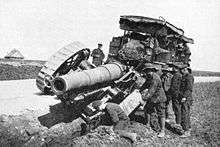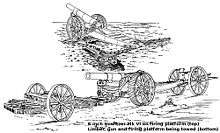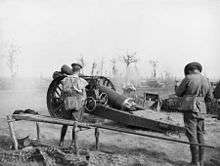BL 8-inch howitzer Mk VI – VIII
| BL 8-inch howitzer Mk VI, VII, VIII | |
|---|---|
|
US-built version of Vickers BL 8-inch howitzer Mk 6 outside the War Museum in Helsinki, Finland | |
| Type | Heavy howitzer |
| Place of origin | United Kingdom |
| Service history | |
| In service | 1916–1943 |
| Used by |
United Kingdom Australia Canada Russian Empire Finland United States |
| Wars | World War I, World War II |
| Production history | |
| Designer | Vickers |
| Designed | 1915 |
| Manufacturer |
Vickers Armstrong Beardmore Woolwich Midvale Steel, major assemblies by Hadfield and Beyer Peacock.[1] |
| Number built | 711 equivalent complete equipments(UK contracts).[2] |
| Specifications | |
| Weight | 8.74 tonnes |
| Barrel length |
Mk VI: 9 feet 9 inches (2.972 m) Mk VII & VIII: 11 feet 6 inches (3.505 m) |
|
| |
| Shell | HE 200 lb (91 kg) |
| Calibre | 8-inch (203.2 mm) |
| Breech | Welin interrupted screw with Asbury mechanism |
| Recoil | Hydro-pneumatic recuperator, hydraulic buffer |
| Carriage | Wheeled, box trail |
| Elevation |
Mk VI: −4° to 50° Mk VII & VIII: 0° to 45° |
| Traverse | 4° L & R |
| Muzzle velocity |
Mk VI: 1,300 ft/s (400 m/s) Mk VII & VIII: 1,500 ft/s (460 m/s) |
| Effective firing range |
Mk VI: 10,745 yd (9,825 m) Mk VII & VIII: 12,300 yd (11,200 m) |
The BL 8-inch howitzer Marks VI, VII and VIII (6, 7 and 8)[note 1] were a series of British artillery siege howitzers on mobile carriages of a new design introduced in World War I. They were designed by Vickers in Britain and produced by all four British artillery manufacturers, but mainly by Armstrong, and one American company. They were the equivalents of the German 21 cm Morser 16 and in British service were used similarly to the BL 9.2-inch howitzer, but were quicker to manufacture, and more mobile. They delivered a 200 lb shell to 12,300 yards. They had limited service in the British Army in World War II before being converted to the new 7.2-inch calibre. They also equipped a small number of Australian and Canadian batteries in World War I and by the US Army in that war. They were used in small numbers by other European armies.
Design and variants

8 inch was a calibre adopted in the First World War by the British Army. The Marks VI, VII and VIII (6, 7 and 8) were a new design and not related to the stopgap early Marks 1–5 of 8-inch howitzer, which used shortened and bored-out naval 6-inch gun barrels.
Mark VI
The Vickers design, very similar to their 6-inch howitzer, was approved in August 1915 and first substantial order placed in March 1916 for 50 howitzers, with 30 more in the autumn.[1] It was 4–5 tonnes lighter than the improvised 8-inch "howitzers" Mks I – V. The Mk VI barrel was of built-up construction and was 14.7 calibres (117.7 inches) long, with a range of 10,745 yards (9,825 m).
Mark VII
Introduced July 1916. Mk VII had a longer barrel (17.3 calibres, or 138.4 inches) of wire-wound construction and increased the range to 12,300 yards (11,250 m). The new barrels turned out to have short lives and suffered from cracked A tubes (the inner rifled layer of the built-up barrel).
Mark VIII

Mk VIII incorporated various small improvements and a thicker and stronger barrel.
Combat use
World War I


Early problems of stability on very hard or soft ground became apparent with the Mk VI, leading to the recoil system not functioning correctly. A Commission went to France to investigate, and a special level "Vickers platform" was adopted, to which the wheels and trail were secured for accurate shooting. A major change in the line of shooting required the platform to be relaid. Setting up and adjusting the platform was labour-intensive.[3] The US manual describes it:[4]
"The platform consists of wooden beams which assemble to form a triangular platform. The spade must be removed and a special bracket fitted on the trail when using this platform. This bracket travels in a groove which gives a bearing for the bracket and also provides a means of traversing the piece 52° on the platform. The main objects in the use of the firing platform are: To provide a reliable support for the wheels and rear end of the trail, so as to prevent sinking or movement when firing on soft ground; to ensure the gun remaining on the target when firing; and to provide means for shifting the trail transversely through an angle of 52° (26° each side of center). By using the traversing gear on the carriage a total traverse of 30° on each side of the center is obtainable... The carriage wheels rest on steel plates on the wheel platform and are guided by curved-steel angles which prevent lateral movement of the gun off the target when in action. When the firing platform is used, the float plate, with spade attached, which is bolted to the underside of the trail, is removed and another float plate, having a thrust bracket attached, is bolted in its place".
At the end of World War I on the Western Front Canada had two 6-gun batteries, Australia 1, Britain 37.[5] British 8-inch howitzer batteries serving in other theatres at the Armistice were: UK 1 (6 guns), Macedonia 1 (4 guns), and 2 guns in Palestine[6]
World War II

By the start of World War II some Mk 8 were still in use and were used in France in May to June 1940. After the Fall of France, remaining guns were used for training only. The advent of the BL 7.2-inch howitzer meant that remaining 8-inch barrels were relined to 7.2 inch. With no guns left, they were declared obsolete by July 1943.
Use by United States

Versions of Mk 6 were manufactured in the United States by Midvale Steel and Ordnance Co, Nicetown, Pennsylvania during World War I, initially supplied to Britain and then used to equip US forces when it entered the war.
A US Mk 8 1⁄2 version was also manufactured and adopted in US service from October 1918.[7] Quoting from the US Army manual of 1920 on artillery in US service:[8]
"The 8 inch howitzer materiel is called the "Vickers" model of 1917, of which there are in use two types, the Mark VI and Mark VII. The main differences between the Mark VI and Mark VII being that the former has a lower muzzle velocity and consequently a shorter range than the latter, also that the Mark VII has a barrel of the "wire wound" construction, whereas the Mark VI type is of the "built up" construction...
The Mark VII has lately been superseded by a Mark VIII 1⁄2, the difference between the two being that the powder chamber walls of the Mark VII proved to be too thin, while the Mark VIII 1⁄2 overcomes this defect by having thicker powder chamber walls...
... the average life of the 8-inch howitzer, Mark VI, [before the barrel needs relining] is 7,800 rounds, while that of the Mark VIII 1⁄2 is 3,000 rounds.
The Mark VI howitzer has a muzzle velocity of 1,300 feet per second and a maximum range of 10,760 yards and is of British design and both British and American manufacture. The Mark VII howitzer has a muzzle velocity of 1,525 feet per second and maximum range of 12,280 yards and is of British design and manufacture.
The Mark VIII 1⁄2 is an American modification of the British wire-wound Mark VIII howitzer to permit of a built up type of construction and is strictly of American manufacture. The Mark VIII 1⁄2 has the same muzzle velocity and range as the Mark VIII.
Due to the combination of British and American manufacture, there are several types of breech mechanism in service; the two main types are the T and the French percussion type...
The Mark VIII 1⁄2 howitzer is also of the built-up-construction type, but differs from the Mark VI howitzer in that it consists of two tubes, an inner and an outer, over which is shrunk the jacket. The jacket in this case supports the howitzer, without the use of guide rings. A breech ring is shrunk on over the jacket and carries a lug for connecting the gun to the recoil mechanism. A breech bushing similar to that of the Mark VI is fitted for the breech mechanism. The total length of this howitzer is about 12 1⁄2 feet [compared to Mk VI 10 1⁄2 feet] and its maximum range is approximately 12,360 yards. This howitzer is mounted on the Mark VII carriage".
The 58th Regiment Coast Artillery Corps (C.A.C.) was in action in France in the final days of World War I with the US-manufactured Mk 6, and the 44th, 51st, and 59th Regiments were in action with British-manufactured versions. An additional six regiments, three with each type of gun, are described as being nearly ready for the front at the time of the Armistice.[9] Each regiment had an authorised strength of 24 guns.
Use by Finland
During the Russo-Finnish Winter War Finland found itself in dire need of heavy artillery. Thirty-two "8 in Howitzer Mk 7 (Vickers Mk 6)" 8-inch howitzers were bought from the United States in 1939 but arrived too late to see action in the war. The howitzers were given the designation 203 H 17 (203 mm, Haupitsi [Finnish for howitzer], 1917) and were first issued to three heavy artillery battalions (1st, 2nd and 3rd), which later were re-organised into six heavy artillery batteries (11th, 12th, 13th, 14th, 15th and 16th). The howitzer was well-liked by the Finnish army for its durability. Thirteen of these howitzers were lost in the battles of the summer of 1944; eight of these belonged to Heavy Artillery Battery 4 and were lost at Valkeasaari on 10 June, while the other five belonged to Heavy Artillery Battery 3, located northeast of Lake Ladoga. The howitzers were stored after the war and were stricken from the lists in the late 1960s.[10]
Operators
 Australia – 6 pieces, 54th Siege Artillery Battery, Royal Australian Artillery
Australia – 6 pieces, 54th Siege Artillery Battery, Royal Australian Artillery Finland – 32 artillery pieces, known as 203 H 17
Finland – 32 artillery pieces, known as 203 H 17 France
France.svg.png) South Africa
South Africa United Kingdom – Royal Garrison Artillery (amalgamated in 1924 into Royal Artillery)
United Kingdom – Royal Garrison Artillery (amalgamated in 1924 into Royal Artillery) United States – (see History Of The Fifty-Eighth Artillery C.A.C.)
United States – (see History Of The Fifty-Eighth Artillery C.A.C.) Russia – 72 howitzers Mk VI (203 mm howitzer Mk. 1916). Also served in Red Army.
Russia – 72 howitzers Mk VI (203 mm howitzer Mk. 1916). Also served in Red Army.
Image gallery
-

Mk III high-explosive shell -

Vickers 8-inch howitzer being loaded, Western Front, 1917 -

howitzers of Australian 54th Siege Artillery Battery, Western Front, 1917 -

bringing up shells by light rail for the howitzers of Australian 54th Siege Artillery Battery, Western Front, 1917 -

A gun not on Vickers platform, has scotches behind wheels to steady it
Surviving examples
- National Defence College Military Museum, Helsinki Finland
- Artillery Museum, Hämeenlinna, Finland
- Mk VIII at Canadian War Museum, Ottawa, Canada
See also
Weapons of comparable role, performance and era
- 21 cm Mörser 16 Approximate German equivalent
Notes
- ↑ Britain used Roman numerals to designate Marks (i.e. models) of ordnance until after World War II. Hence this article refers to the sixth, seventh and eighth models of British BL 8-inch howitzers
References
- 1 2 The Official History of the Ministry of Munitions Vol X The Supply of Munitions Part 1 Guns Chap IV Review of the Chief Changes in Gun Design Sect VI Other Modifications in Design & Chap V The Manufacture and Repair of Guns Sect V Supply of the Main Types
- ↑ The Official History of the Ministry of Munitions Vol X The Supply of Munitions Part 1 Guns Appendix Deliveries to Service of Guns and Carrieges from Aug 1914 to Dec 1918 (a) New Guns and Carriages
- ↑ Clarke 2005, page 46
- ↑ Handbook of artillery. United States. Army. Ordnance Dept, May 1920, Page 281
- ↑ Farndale 1986, Annex M Order of Battle France and Flanders 11 November 1918
- ↑ Farndale 1988, Annex 1
- ↑ Hartwell "8-inch British Howitzer"
- ↑ Handbook of Artillery, US Ordnance Dept, May 1920, page 261, 263, 268
- ↑ Hartwell "History of United States Army Coast Artillery Corps During World War One"
- ↑ Paulaharju, p. 148
Bibliography
- Published references
- Dale Clarke, British Artillery 1914–1919. Heavy Artillery. Osprey Publishing, Oxford UK, 2005 ISBN 1-84176-788-3
- Crowell, Benedict (1919). America's Munitions 1917–1918. Washington, DC: Government Printing Office.
- General Sir Martin Farndale, History of the Royal Regiment of Artillery. Western Front 1914–18. London: Royal Artillery Institution, 1986 ISBN 1-870114-00-0
- General Sir Martin Farndale, History of the Royal Regiment of Artillery : Forgotten Fronts and the Home Base 1914-18. London:The Royal Artillery Institution, 1988 ISBN 1-870114-05-1
- I.V. Hogg & L.F. Thurston, "British Artillery Weapons & Ammunition 1914–1918". London: Ian Allan, 1972.
- Handbook of artillery : including mobile, anti-aircraft and trench matériel (1920). United States. Army. Ordnance Dept, May 1920
- Handbook of the Mark VI
- Paulaharju, Jyri (1996). Itsenäisen Suomen kenttätykit 1918–1995. Sotamuseon julkaisuja 1/1996. Sotamuseo. ISBN 951-25-0811-7.
- British National Archives MUN5/373/9227
- Иванов А.: Артиллерия СССР во Второй мировой войне; Нева 2003; Санкт-Петербург
- Internet references
- Ross Mallett, AIF 1914–1918 Artillery
- 8 inch Howitzer Mk VI–VIII at Landships
- Joe Hartwell, Defeating the Hun. History of United States Army Coast Artillery Corps During World War One.
- Joe Hartwell, "8-inch British Howitzer" US-built versions
- History Of The Fifty-Eighth Artillery C.A.C.
- Finnish Army 1918–1945. 203 mm H/17 Howitzer
- Om den engelske 8-tommers haubits 1915–1940 (Danish)
External links
| Wikimedia Commons has media related to BL 8 inch Howitzer Mk VI - VIII. |
- Handbook of the B. L. 8-inch howitzers, marks VI to VIII, on travelling carriages. 1920. Hosted online by State Library of Victoria, Australia
- Gun drill for 8-inch B.L. howitzer Marks VII. VII*, VII** and VIII carriages Marks VII and VIIa 1920 1923 Hosted online by State Library of Victoria, Australia
- War Office (1916). "Chapperton Down Artillery School [film]". IWM Film. Imperial War Museum. 10:01:02:00. Retrieved 1 November 2013.
- Video clips on YouTube
- BL 8-inch Howitzer Marks VI – VIII at Landships
- Bill Maloney, Photograph of example in WWI camouflage paint at Canadian War Museum